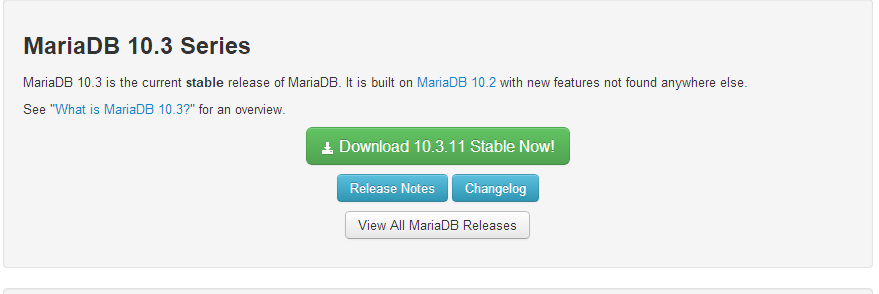文章主要給大家介紹了關(guān)于MariaDB數(shù)據(jù)庫(kù)的外鍵約束的相關(guān)資料,文中通過(guò)示例代碼介紹的非常詳細(xì),需要的朋友可以參考借鑒,下面隨著小編來(lái)一起學(xué)習(xí)學(xué)習(xí)吧
外鍵
外鍵的用途是確保數(shù)據(jù)的完整性。它通常包括以下幾種:
1 實(shí)體完整性,確保每個(gè)實(shí)體是唯一的(通過(guò)主鍵來(lái)實(shí)施)
2 域完整性,確保屬性值只從一套特定可選的集合里選擇
3 關(guān)聯(lián)完整性,確保每個(gè)外鍵或是NULL(如果允許的話)或含有與相關(guān)主鍵值相配的值
1.什么是外鍵約束
與主鍵約束不同,創(chuàng)建外鍵約束不會(huì)自動(dòng)創(chuàng)建對(duì)應(yīng)的索引。 但是由于以下原因,對(duì)外鍵手動(dòng)創(chuàng)建索引通常是有用的:
當(dāng)在查詢中組合相關(guān)表中的數(shù)據(jù)時(shí),經(jīng)常在聯(lián)接條件中使用外鍵列,方法是將一個(gè)表的外鍵約束中的一列或多列與另一個(gè)表中的主鍵列或唯一鍵列匹配。 索引使 數(shù)據(jù)庫(kù)引擎 可以在外鍵表中快速查找相關(guān)數(shù)據(jù)。 但是,創(chuàng)建此索引并不是必需的。 即使沒(méi)有對(duì)兩個(gè)相關(guān)表定義主鍵或外鍵約束,也可以對(duì)來(lái)自這兩個(gè)表中的數(shù)據(jù)進(jìn)行組合,但兩個(gè)表間的外鍵關(guān)系說(shuō)明已用其鍵作為條件對(duì)其進(jìn)行了優(yōu)化,以便組合到查詢中。
對(duì)主鍵約束的更改可由相關(guān)表中的外鍵約束檢查。
外鍵約束(foreign key)就是表與表之間的某種約定的關(guān)系,由于這種關(guān)系的存在,我們能夠讓表與表之間的數(shù)據(jù),更加的完整,關(guān)連性更強(qiáng)。
關(guān)于數(shù)據(jù)表的完整性和關(guān)連性,可以舉個(gè)例子
有二張表,一張是用戶表,一張是訂單表:
1.如果我刪除了用戶表里的用戶,那么訂單表里面跟這個(gè)用戶有關(guān)的數(shù)據(jù),就成了無(wú)頭數(shù)據(jù)了,不完整了。
2.如果我在訂單表里面,隨便插入了一條數(shù)據(jù),這個(gè)訂單在用戶表里面,沒(méi)有與之對(duì)應(yīng)的用戶。這樣數(shù)據(jù)也不完整了。
如果有外鍵的話,就方便多了,可以不讓用戶刪除數(shù)據(jù),或者刪除用戶的話,通過(guò)外鍵同樣刪除訂單表里面的數(shù)據(jù),這樣也能讓數(shù)據(jù)完整。
通過(guò)外鍵約束,每次插入或更新數(shù)據(jù)表時(shí),都會(huì)檢查數(shù)據(jù)的完整性。
2.創(chuàng)建外鍵約束
2.1 方法一:通過(guò)create table創(chuàng)建外鍵
語(yǔ)法:
createtable數(shù)據(jù)表名稱(...,[CONSTRAINT[約束名稱]]FOREIGNKEY[外鍵字段]REFERENCES[外鍵表名](外鍵字段,外鍵字段2…..)[ONDELETECASCADE][ONUPDATECASCADE])
參數(shù)的解釋:
RESTRICT: 拒絕對(duì)父表的刪除或更新操作。
CASCADE: 從父表刪除或更新且自動(dòng)刪除或更新子表中匹配的行。ON DELETE CASCADE和ON UPDATE CASCADE都可用
注意:on update cascade是級(jí)聯(lián)更新的意思,on delete cascade是級(jí)聯(lián)刪除的意思,意思就是說(shuō)當(dāng)你更新或刪除主鍵表,那外鍵表也會(huì)跟隨一起更新或刪除。
精簡(jiǎn)化后的語(yǔ)法:
foreignkey當(dāng)前表的字段references外部表名 (關(guān)聯(lián)的字段) type=innodb
2.1.1 插入測(cè)試數(shù)據(jù)
例子:我們創(chuàng)建一個(gè)數(shù)據(jù)庫(kù),包含用戶信息表和訂單表
MariaDB [book]>createdatabasemarket; # 創(chuàng)建market數(shù)據(jù)庫(kù)Query OK, 1 row affected (0.00 sec)MariaDB [book]> use market; # 使用market數(shù)據(jù)庫(kù)DatabasechangedMariaDB [market]>createtableuserprofile(idint(11)notnullauto_increment,namevarchar(50)notnulldefault'', sexint(1)notnulldefault'0',primarykey(id))ENGINE=innodb; # 創(chuàng)建userprofile數(shù)據(jù)表,指定使用innodb引擎Query OK, 0rowsaffected (0.07 sec)MariaDB [market]>createtableuser_order(o_idint(11) auto_increment, u_idint(11)default'0', usernamevarchar(50), moneyint(11),primarykey(o_id),index(u_id),foreignkeyorder_f_key(u_id)referencesuserprofile(id)ondeletecascadeonupdatecascade); # 創(chuàng)建user_order數(shù)據(jù)表,同時(shí)為user_order表的u_id字段做外鍵約束,綁定userprofile表的id字段Query OK, 0rowsaffected (0.04 sec)MariaDB [market]>insertintouserprofile(name,sex)values('HA',1),('LB',2),('HPC',1); # 向userprofile數(shù)據(jù)表插入三條記錄Query OK, 3rowsaffected (0.01 sec)Records: 3 Duplicates: 0 Warnings: 0MariaDB [market]>select*fromuserprofile; # 查詢userprofile數(shù)據(jù)表的所有記錄+----+------+-----+| id |name| sex |+----+------+-----+| 1 | HA | 1 || 2 | LB | 2 || 3 | HPC | 1 |+----+------+-----+3rowsinset(0.00 sec)MariaDB [market]>insertintouser_order(u_id,username,money)values(1,'HA',234),(2,'LB',146),(3,'HPC',256); # 向user_order數(shù)據(jù)表插入三條記錄Query OK, 3rowsaffected (0.02 sec)Records: 3 Duplicates: 0 Warnings: 0MariaDB [market]>select*fromuser_order; # 查詢user_order數(shù)據(jù)表的所有記錄+------+------+----------+-------+| o_id | u_id | username | money |+------+------+----------+-------+| 1 | 1 | HA | 234 || 2 | 2 | LB | 146 || 3 | 3 | HPC | 256 |+------+------+----------+-------+3rowsinset(0.00 sec)MariaDB [market]>selectid,name,sex,money,o_idfromuserprofile,user_orderwhereid=u_id; # 聯(lián)表查詢+----+------+-----+-------+------+| id |name| sex | money | o_id |+----+------+-----+-------+------+| 1 | HA | 1 | 234 | 1 || 2 | LB | 2 | 146 | 2 || 3 | HPC | 1 | 256 | 3 |+----+------+-----+-------+------+3rowsinset(0.03 sec)
2.1.2 測(cè)試級(jí)聯(lián)刪除
MariaDB [market]>deletefromuserprofilewhereid=1; # 刪除user表中id為1的數(shù)據(jù)Query OK, 1 row affected (0.01 sec)MariaDB [market]>selectid,name,sex,money,o_idfromuserprofile,user_orderwhereid=u_id;+----+------+-----+-------+------+| id |name| sex | money | o_id |+----+------+-----+-------+------+| 2 | LB | 2 | 146 | 2 || 3 | HPC | 1 | 256 | 3 |+----+------+-----+-------+------+2rowsinset(0.00 sec)MariaDB [market]>select*fromuser_order; # 查看order表的數(shù)據(jù)+------+------+----------+-------+| o_id | u_id | username | money |+------+------+----------+-------+| 2 | 2 | LB | 146 || 3 | 3 | HPC | 256 |+------+------+----------+-------+3rowsinset(0.00 sec)
2.1.3 測(cè)試級(jí)聯(lián)更新
更新數(shù)據(jù)之前的狀態(tài)
MariaDB [market]>select*fromuserprofile; # 查看userprofile表的數(shù)據(jù)+----+------+-----+| id |name| sex |+----+------+-----+| 2 | LB | 2 || 3 | HPC | 1 |+----+------+-----+3rowsinset(0.00 sec)MariaDB [market]>select*fromuser_order; # 查看order表的數(shù)據(jù)+------+------+----------+-------+| o_id | u_id | username | money |+------+------+----------+-------+| 2 | 2 | LB | 146 || 3 | 3 | HPC | 256 |+------+------+----------+-------+3rowsinset(0.00 sec)
更新數(shù)據(jù)?
MariaDB [market]>updateuserprofilesetid=6whereid=2; # 把userprofile數(shù)據(jù)表中id為2的用戶改為id為6Query OK, 1 row affected (0.02 sec)Rowsmatched: 1 Changed: 1 Warnings: 0
更新數(shù)據(jù)后的狀態(tài)?
MariaDB [market]>selectid,name,sex,money,o_idfromuserprofile,user_orderwhereid=u_id; # 聯(lián)表查詢,可以看出表中已經(jīng)沒(méi)有id為2的用戶了+----+------+-----+-------+------+| id |name| sex | money | o_id |+----+------+-----+-------+------+| 6 | LB | 2 | 146 | 2 || 3 | HPC | 1 | 256 | 3 |+----+------+-----+-------+------+2rowsinset(0.00 sec)MariaDB [market]>select*fromuserprofile; # 查看userprofile表的數(shù)據(jù),id只剩下3和6+----+------+-----+| id |name| sex |+----+------+-----+| 3 | HPC | 1 || 6 | LB | 2 |+----+------+-----+2rowsinset(0.00 sec)MariaDB [market]>select*fromuser_order; # 查看user_order表的數(shù)據(jù),u_id也改為6+------+------+----------+-------+| o_id | u_id | username | money |+------+------+----------+-------+| 2 | 6 | LB | 146 || 3 | 3 | HPC | 256 |+------+------+----------+-------+2rowsinset(0.00 sec)
2.1.4 測(cè)試數(shù)據(jù)完整性
MariaDB [market]>insertintouser_order(u_id,username,money)values(5,"XJ",345); # 單獨(dú)向user_order數(shù)據(jù)表中插入數(shù)據(jù),插入數(shù)據(jù)失敗ERROR 1452 (23000): Cannotaddorupdatea child row: aforeignkeyconstraintfails (`market`.`user_order`,CONSTRAINT`user_order_ibfk_1`FOREIGNKEY(`u_id`)REFERENCES`userprofile` (`id`)ONDELETECASCADEONUPDATECASCADE)
在上面的例子中,user_order表的外鍵約束,user_order表受userprofile表的約束
在user_order里面插入一條數(shù)據(jù)u_id為5用戶,在userprofile表里面根本沒(méi)有,所以插入數(shù)據(jù)失敗
先向userprofile表中插入記錄,再向user_order表中插入記錄就可以了
MariaDB [market]>insertintouserprofilevalues(5,"XJ",1); # 先向userprofile數(shù)據(jù)表中插入id為5的記錄,插入數(shù)據(jù)成功Query OK, 1 row affected (0.01 sec)MariaDB [market]>insertintouser_order(u_id,username,money)values(5,"XJ",345); # 再向user_order數(shù)據(jù)表中插入數(shù)據(jù),成功Query OK, 1 row affected (0.00 sec)MariaDB [market]>select*fromuserprofile; # 查詢userprofile數(shù)據(jù)表中的所有記錄+----+------+-----+| id |name| sex |+----+------+-----+| 3 | HPC | 1 || 5 | XJ | 1 || 6 | LB | 2 |+----+------+-----+3rowsinset(0.00 sec)MariaDB [market]>select*fromuser_order; # 查詢user_order數(shù)據(jù)表中的所有記錄+------+------+----------+-------+| o_id | u_id | username | money |+------+------+----------+-------+| 2 | 6 | LB | 146 || 3 | 3 | HPC | 256 || 5 | 5 | XJ | 345 |+------+------+----------+-------+3rowsinset(0.01 sec)
2.2 方法二:通過(guò)alter table創(chuàng)建外鍵和級(jí)聯(lián)更新,級(jí)聯(lián)刪除
語(yǔ)法:
altertable數(shù)據(jù)表名稱add[constraint[約束名稱] ]foreignkey(外鍵字段,..)references數(shù)據(jù)表(參照字段,...)[onupdatecascade|setnull|noaction][ondeletecascade|setnull|noaction])
例子:
MariaDB [market]>createtableuser_order1(o_idint(11) auto_increment,u_idint(11)default"0",usernamevarchar(50),moneyint(11),primarykey(o_id),index(u_id)); # 創(chuàng)建user_order1數(shù)據(jù)表,創(chuàng)建表時(shí)不使用外鍵約束Query OK, 0rowsaffected (0.11 sec)MariaDB [market]> showcreatetableuser_order1; # 查看user_order1數(shù)據(jù)表的創(chuàng)建信息,沒(méi)有外鍵約束+-------------+----------------------------------------------------------------------------------------------------------------------------------------------------------------------------------------------------------------------------------------------------------------------------------------------------------------+|Table|CreateTable|+-------------+----------------------------------------------------------------------------------------------------------------------------------------------------------------------------------------------------------------------------------------------------------------------------------------------------------------+| user_order1 |CREATETABLE`user_order1` (`o_id`int(11)NOTNULLAUTO_INCREMENT,`u_id`int(11)DEFAULT'0',`username`varchar(50)COLLATEutf8_unicode_ciDEFAULTNULL,`money`int(11)DEFAULTNULL,PRIMARYKEY(`o_id`),KEY`u_id` (`u_id`)) ENGINE=InnoDBDEFAULTCHARSET=utf8COLLATE=utf8_unicode_ci |+-------------+----------------------------------------------------------------------------------------------------------------------------------------------------------------------------------------------------------------------------------------------------------------------------------------------------------------+1 rowinset(0.01 sec)MariaDB [market]>altertableuser_order1addforeignkey(u_id)referencesuserprofile(id)ondeletecascadeonupdatecascade; # 使用alter修改user_order1數(shù)據(jù)表,為user_order1數(shù)據(jù)表添加外鍵約束Query OK, 0rowsaffected (0.05 sec)Records: 0 Duplicates: 0 Warnings: 0MariaDB [market]> showcreatetableuser_order1; # 查看user_order1數(shù)據(jù)表的創(chuàng)建信息,已經(jīng)添加了外鍵約束+-------------+--------------------------------------------------------------------------------------------------------------------------------------------------------------------------------------------------------------------------------------------------------------------------------------------------------------------------------------------------------------------------------------------------------------------------------------------+|Table|CreateTable|+-------------+--------------------------------------------------------------------------------------------------------------------------------------------------------------------------------------------------------------------------------------------------------------------------------------------------------------------------------------------------------------------------------------------------------------------------------------------+| user_order1 |CREATETABLE`user_order1` (`o_id`int(11)NOTNULLAUTO_INCREMENT,`u_id`int(11)DEFAULT'0',`username`varchar(50)COLLATEutf8_unicode_ciDEFAULTNULL,`money`int(11)DEFAULTNULL,PRIMARYKEY(`o_id`),KEY`u_id` (`u_id`),CONSTRAINT`user_order1_ibfk_1`FOREIGNKEY(`u_id`)REFERENCES`userprofile` (`id`)ONDELETECASCADEONUPDATECASCADE) ENGINE=InnoDBDEFAULTCHARSET=utf8COLLATE=utf8_unicode_ci |+-------------+--------------------------------------------------------------------------------------------------------------------------------------------------------------------------------------------------------------------------------------------------------------------------------------------------------------------------------------------------------------------------------------------------------------------------------------------+1 rowinset(0.00 sec)
3.刪除外鍵
語(yǔ)法
altertable數(shù)據(jù)表名稱dropforeignkey約束(外鍵)名稱
例子:
MariaDB [market]> showcreatetableuser_order1; # 查看user_order1數(shù)據(jù)表的創(chuàng)建信息,包含外鍵約束+-------------+--------------------------------------------------------------------------------------------------------------------------------------------------------------------------------------------------------------------------------------------------------------------------------------------------------------------------------------------------------------------------------------------------------------------------------------------+|Table|CreateTable|+-------------+--------------------------------------------------------------------------------------------------------------------------------------------------------------------------------------------------------------------------------------------------------------------------------------------------------------------------------------------------------------------------------------------------------------------------------------------+| user_order1 |CREATETABLE`user_order1` (`o_id`int(11)NOTNULLAUTO_INCREMENT,`u_id`int(11)DEFAULT'0',`username`varchar(50)COLLATEutf8_unicode_ciDEFAULTNULL,`money`int(11)DEFAULTNULL,PRIMARYKEY(`o_id`),KEY`u_id` (`u_id`),CONSTRAINT`user_order1_ibfk_1`FOREIGNKEY(`u_id`)REFERENCES`userprofile` (`id`)ONDELETECASCADEONUPDATECASCADE) ENGINE=InnoDBDEFAULTCHARSET=utf8COLLATE=utf8_unicode_ci |+-------------+--------------------------------------------------------------------------------------------------------------------------------------------------------------------------------------------------------------------------------------------------------------------------------------------------------------------------------------------------------------------------------------------------------------------------------------------+1 rowinset(0.00 sec)MariaDB [market]>altertableuser_order1dropforeignkeyuser_order1_ibfk_1; # 為user_order1數(shù)據(jù)表刪除外鍵約束,外鍵名稱必須與從`showcreatetableuser_order1`語(yǔ)句中查到的相同Query OK, 0rowsaffected (0.05 sec)Records: 0 Duplicates: 0 Warnings: 0MariaDB [market]> showcreatetableuser_order1; # 查看user_order1數(shù)據(jù)表的創(chuàng)建信息,外鍵約束已經(jīng)被刪除了+-------------+----------------------------------------------------------------------------------------------------------------------------------------------------------------------------------------------------------------------------------------------------------------------------------------------------------------+|Table|CreateTable|+-------------+----------------------------------------------------------------------------------------------------------------------------------------------------------------------------------------------------------------------------------------------------------------------------------------------------------------+| user_order1 |CREATETABLE`user_order1` (`o_id`int(11)NOTNULLAUTO_INCREMENT,`u_id`int(11)DEFAULT'0',`username`varchar(50)COLLATEutf8_unicode_ciDEFAULTNULL,`money`int(11)DEFAULTNULL,PRIMARYKEY(`o_id`),KEY`u_id` (`u_id`)) ENGINE=InnoDBDEFAULTCHARSET=utf8COLLATE=utf8_unicode_ci |+-------------+----------------------------------------------------------------------------------------------------------------------------------------------------------------------------------------------------------------------------------------------------------------------------------------------------------------+1 rowinset(0.00 sec)
4.使用外鍵約束的條件
要想外鍵創(chuàng)建成功,必須滿足以下4個(gè)條件:
1、確保參照的表和字段存在。
2、組成外鍵的字段被索引。
3、必須使用type指定存儲(chǔ)引擎為:innodb.
4、外鍵字段和關(guān)聯(lián)字段,數(shù)據(jù)類型必須一致。
5.使用外鍵約束需要的注意事項(xiàng)
1.on delete cascade on update cascade 添加級(jí)聯(lián)刪除和更新:
2.確保參照的表userprofile中id字段存在。
3.確保組成外鍵的字段u_id被索引
4.必須使用type指定存儲(chǔ)引擎為:innodb。
5.外鍵字段和關(guān)聯(lián)字段,數(shù)據(jù)類型必須一致。
總結(jié)
以上就是這篇文章的全部?jī)?nèi)容了,希望本文的內(nèi)容對(duì)大家的學(xué)習(xí)或者工作具有一定的參考學(xué)習(xí)價(jià)值。
- Windows10系統(tǒng)下MariaDB數(shù)據(jù)庫(kù)安裝教程圖解
- Mysql數(shù)據(jù)庫(kù)大表優(yōu)化方案和Mysql大表優(yōu)化步驟
- Mysql數(shù)據(jù)庫(kù)創(chuàng)建存儲(chǔ)過(guò)程實(shí)現(xiàn)往數(shù)據(jù)表中新增字段的方
- Mysql數(shù)據(jù)庫(kù)自定義函數(shù)的定義、使用方法及操作注意事
- Mysql數(shù)據(jù)庫(kù)的max_allowed_packet設(shè)定方法
- Mysql數(shù)據(jù)庫(kù)亂碼出現(xiàn)的各個(gè)階段以及對(duì)應(yīng)方法
- MySQL數(shù)據(jù)庫(kù)的事務(wù)處理用法與實(shí)例代碼詳解
- Mysql數(shù)據(jù)庫(kù)使用from與join兩表查詢的方法區(qū)別總結(jié)
- Sql Server數(shù)據(jù)庫(kù)類似正則表達(dá)式的字符處理問(wèn)題
- SQL Server數(shù)據(jù)庫(kù)中表和索引結(jié)構(gòu)存儲(chǔ)的原理及如何加快







